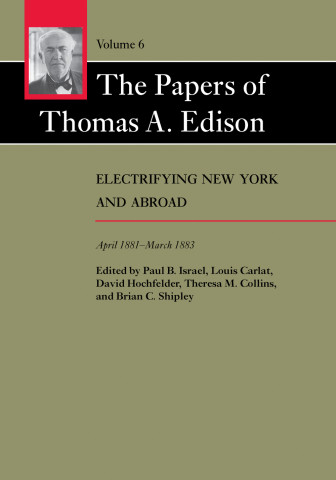
Reviews
A mine of material... Scrupulously edited... No one could ask for more... A choplicking feast for future Edison biographers—well into the next century, and perhaps beyond.
A triumph of the bookmaker's art, with splendidly arranged illustrations, essential background information, and cautionary reminders of the common sources on which Edison's imagination drew.
In the pages of this volume Edison the man, his work, and his times come alive... A delight to browse through or to read carefully.
Beyond its status as the resource for Edison studies, providing a near inexhaustible supply of scholarly fodder, this series... will surely become a model for such projects in the future... The sheer diversity of material offered here refreshingly transcends any exclusive restriction to Edisonia.
What is most extraordinary about the collection isn't necessarily what it reveals about Edison's inventions... It's the insight into the process.
Those interested in America's technological culture can eagerly look forward to the appearance of each volume of the Edison Papers.
His lucidity comes through everywhere... His writing and drawing come together as a single, vigorous thought process.
For those who want to delve deeply into Edison's life and business dealings, this is another essential key to the puzzle.
In its superabundance of detail—steely facts and figures, great plates of text riveted with nouns and graffitied with cryptic drawings (Edison was an untrained but natural draftsman)—the book has the same kind of physical impact as that which stuns you when you enter his laboratory in West Orange, N.J.
Book Details
Calendar of Documents
List of Editorial Headnotes
List of Maps
Preface
Chronology of Thomas A. Edison, January 1888–December 1889
Editorial Policy and User's Guide
Editorial Symbols
List of Abbreviations
–1–
Calendar of Documents
List of Editorial Headnotes
List of Maps
Preface
Chronology of Thomas A. Edison, January 1888–December 1889
Editorial Policy and User's Guide
Editorial Symbols
List of Abbreviations
–1– January–March 1888 (Docs. 3128–3172)
–2– April–June 1888 (Docs. 3173–3219)
–3– July–September 1888 (Docs. 3220–3266)
–4– October–December 1888 (Docs. 3267–3304)
–5– January–March 1889(Docs. 3305–3338)
–6– April–June 1889 (Docs. 3339–3372) 594
–7– July–September 1889 (Docs. 3373–3419)
–8– October–December 1889 (Docs. 3420–3458)
Appendix 1. Edison's Autobiographical Notes
Appendix 2. Edison's Draft List of Inventions for Henry Villard
Appendix 3. List of Edison's "Dead Experiments for 1888"
Appendix 4. Laboratory Experimental Staff, 1888–1889
Appendix 5. Edison's U.S. Patent Applications, 1888–1889
Bibliography
Credits
Index





